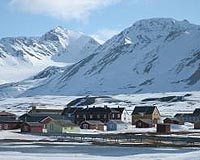| . |  |
. |
Geneva (AFP) Sept 2, 2009 Global warming in the Arctic could affect a quarter of the world's population through flooding and amplify the wider impact of climate change, a report by environmental group WWF said Wednesday. Air temperatures in the region have risen by almost twice the global average over the past few decades, according to the peer-reviewed scientific report. That is not just down to melting the polar ice pack, a major cooling agent for global weather patterns and reflector of sunlight. It is also linked to the release of more of the greenhouse gases responsible for global warming that are naturally trapped in frozen soil, it claimed. "What this report says is that a warming Arctic is much more than a local problem, it's a global problem," said Martin Sommerkorn, senior climate change advisor on the WWF's Arctic Programme. "Simply put, if we do not keep the Arctic cold enough, people across the world will suffer the effects," he warned. The combination of thawing Arctic sea ice and melting ice sheets in Greenland and West Antarctica was likely to raise global sea levels by about 1.2 metres (four feet) by 2100, more than previously thought, according to scientists commissioned by the WWF for the report. "The associated flooding of coastal regions will affect more than a quarter of the world's population," the WWF said. Scientists have expressed concern in recent years about the now visible melting of the Arctic region, to the extent that some have predicted virtually ice-free summers there this century. The full impact of polar melting has yet to be taken into account by the Intergovernmental Panel on Climate Change, the scientific reference for world climate predictions, as reliable observations have only started to emerge in recent years. Sommerkorn said the melting was already having an effect on the weather in the northern hemisphere, such as drier conditions in Scandinavia or the southwest of North America, or more humid Mediterranean winters. However some climatologists at the World Climate Conference here urged caution about such short-term judgments, while acknowledging the major long-term influence of Arctic melting on the world's climate. "We see that summer sea ice is likely to disappear by 2060," said Vicky Pope, head of climate change advice at Britain's Met Office. "But I don't think we understand the physics yet," she added, pointing to possible natural variability to account for recent local weather patterns. The WWF report concluded that melting sea ice and the release of pockets of greenhouse gases -- carbon dioxide from thawing permafrost and methane seeping from the depths of the warming Arctic Ocean -- would also fuel disruption to atmospheric and ocean currents much further afield. Arctic permafrost stores twice as much carbon as contained in the atmosphere, acording to the WWF. Some 90 percent of near surface permafrost in the Arctic could disappear by the end of the century, the report found. That trend could significantly accelerate global warming and force a shift in emissions targets, Sommerkorn told journalists. "If we allow the Arctic to get much warmer it is really doubtful whether we will be able to keep the Arctic climate feedbacks under control," he said. UN Secretary General Ban Ki-moon, who is due at the conference later this week, on Wednesday urged world leaders to act now to halt global warming, after seeing first-hand its effects in the Arctic during a visit to Norway. "The Arctic is similar to sending a canary into a coalmine -- this is a danger warning for the global climate," he said. World leaders will gather at a UN climate summit in Copenhagen in December to try and seal a new international accord on fighting climate change. Share This Article With Planet Earth
Related Links Beyond the Ice Age
 UN chief 'alarmed' at Arctic glacier melt
UN chief 'alarmed' at Arctic glacier meltNy-Aalesund, Norway (AFP) Sept 1, 2009 UN Secretary General Ban Ki-moon said Tuesday he was "alarmed" by the rate at which the Arctic's glaciers are retreating as he visited the region ahead of key climate talks in December. Ban said world leaders had a "moral political responsibility" to safeguard the future of the planet. "I am very much alarmed and surprised to have seen these glaciers all worn," he told journalists as he ... read more |
|
| The content herein, unless otherwise known to be public domain, are Copyright 1995-2009 - SpaceDaily. AFP and UPI Wire Stories are copyright Agence France-Presse and United Press International. ESA Portal Reports are copyright European Space Agency. All NASA sourced material is public domain. Additional copyrights may apply in whole or part to other bona fide parties. Advertising does not imply endorsement,agreement or approval of any opinions, statements or information provided by SpaceDaily on any Web page published or hosted by SpaceDaily. Privacy Statement |